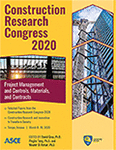Construction Research Congress 2020
South Atlantic Architects Validation Case Study of “How” Decisions Are Made for the CDMI Tool
Publication: Construction Research Congress 2020: Project Management and Controls, Materials, and Contracts
ABSTRACT
Architects are an integral part of the design and construction industry and are continuously incorporating decisions that influence projects during their life cycle. These decisions aim at selecting the best alternative from the ones available. Unfortunately, this decision-making process is mainly unexplored in the industry. No instrument to measure construction decisions, based on a knowledge base of decision-makers, has existed. Also, limited literature is available on the topic. Recently, the first instrument to gain an understanding of the construction decision-making process was developed by Dr. Tulio Sulbaran from the University of Texas at San Antonio. The instrument’s name is “construction decision making inventory (CDMI).” The CDMI is an innovative idea to measure the “How” of the construction decision making inventory. As an innovative idea, its statistical validity (accuracy of the assessment) is yet to be assessed. Thus, the purpose of this paper is to describe the results of a case study with architects in the southeast of the United States aimed to determine CDMI validity. The results of the case study are significant because they assess the validity of the tool. Furthermore, as the architects evaluated each question within the measurements, this study is also guiding the enhancement of the CDMI.
Get full access to this article
View all available purchase options and get full access to this chapter.
References
American Educational Research Association, American Psychological Association, &National Council on Measurement in Education. (1999). Standards for educational and psychological testing. Washington, DC: American Educational Research Association.
Ayre, C., and Scally, A. (2013). Critical Values for Lawshe’s Content Validity Ratio. Measurement and Evaluation in Counseling and Development, 47, 79–86. https://doi.org/10.1177/0748175613513808.
Hackler, J., and Holdren, J. P. (2008). Walking the Talk and Walking the walk at the Woods Hole Research Center: Design and Performance of an Award-Winning Green Headquarters” Journal of Green Building, 3(1), 3-13.
Herriott, R.E., and Firestone, W.A. (1983). “Multisite qualitative policy research: Optimizing description and generalizability.” Educational Research, 12(2), 14-19.
Kobet, B., Powers, W., Lee, S., Mondor, C., and Mondor, M. (1999). High-Performance Green Buildings, Pennsylvania Department of Environmental Protection.
Ku, K., and Mills, T. (2010). “Research needs for building information modeling for construction safety.” Proc., 46th ASC Annual Conf., Associated Schools of Construction, Boston, MA.
Langar, S., and Pearce, A. R. (2017). “Implementation trends for Rainwater Harvesting Technologies and Strategies (RwHTS) and Building Information Modeling (BIM).” Journal of Architecture Engineering (ASCE), 23 (1).
Lawshe, C. H. (1975). A quantitative approach to content validity. Personnel Psychology, 28, 563–575.
Mohammed, H.M., Langar, S., Ghosh, S., and Bhattacharjee, S. (2016). “Prevention through Design (PtD): Current State of Knowledge and Implementation in the Design Industry.” Proceedings of 52nd Associated School of Construction International Conference, Provo, UT, April 13- 16.
Pena-Mora, F., and Dwivedi, G. H. (2002). “Multiple Device Collaborative and Real-Time Analysis System for Project Management in Civil Engineering.” Journal of Computing in Civil Engineering, 16 (1), 23-38.
Soy, S. (1997). “The case study as a research method.” The University of Texas at Austin.
Szafranko, E. (2017). “Decision problems in the management of construction projects.” IOP Conf. Series: Materials Science and Engineering, 227 (1), 14–17 June 2017, Sibiu, Romania.
The American Institute of Architects. (2018). “Architect Membership.” Also Available at <https://www.aia.org/pages/21891-architect-membership>
United States Department of Labor. Bureau of Labor Statistics (BLS). (2016).
Whole Building Design Guide. (WBDG). (2012). “Architecture.” http://www.wbdg.org/design/dd_architecture.phpi (Jul. 25, 2017).
Yates, J. K. (1994). Construction competition and competitive strategies, Journal of Management in Engineering, 10(1).
Yin, R.K. (1984). Case Study Research: Design and Methods. Sage Publications, Beverly Hills, California.
Information & Authors
Information
Published In
Construction Research Congress 2020: Project Management and Controls, Materials, and Contracts
Pages: 259 - 270
Editors: David Grau, Ph.D., Arizona State University, Pingbo Tang, Ph.D., Arizona State University, and Mounir El Asmar, Ph.D., Arizona State University
ISBN (Online): 978-0-7844-8288-9
Copyright
© 2020 American Society of Civil Engineers.
History
Published online: Nov 9, 2020
Published in print: Nov 9, 2020
Authors
Metrics & Citations
Metrics
Citations
Download citation
If you have the appropriate software installed, you can download article citation data to the citation manager of your choice. Simply select your manager software from the list below and click Download.
